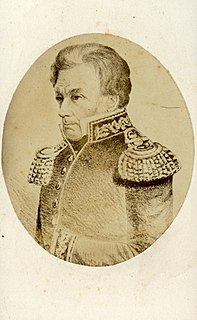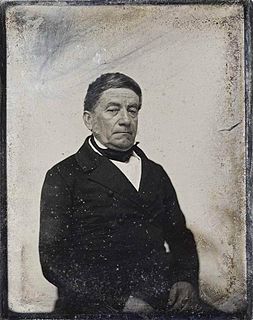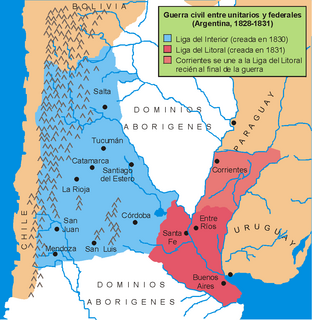
Juan Facundo Quiroga was an Argentine caudillo who supported federalism at the time when the country was still in formation.

Juan José Viamonte González was an Argentine general in the early 19th century.

Estanislao López was a caudillo and governor of the province of Santa Fe, Argentina, between 1818 and 1838, one of the foremost proponents of provincial federalism, and an associate of Juan Manuel de Rosas during the Argentine Civil War. He is considered an iconic figure in Santa Fe and one of the most influential political actors in the Argentine conflicts of the 1820s and 1830s.

The Federalist Party was the nineteenth century Argentine political party that supported federalism. It opposed the Unitarian Party that claimed a centralised government of Buenos Aires Province, with no participation of the other provinces of the custom taxes benefits of the Buenos Aires port. The federales supported the autonomy of the provincial governments and the distribution of external commerce taxes among the provinces.

Brigadier General José María Paz y Haedo was an Argentine military figure, notable in the Argentine War of Independence and the Argentine Civil War.

The San Nicolás Agreement was a pact signed on May 31, 1852 and subscribed by all but one of the 14 provinces of the United Provinces of the River Plate. The treaty consisted of 19 articles, and its goal was to set the bases for the national organization of the young Argentine state. It also served as precedent to the sanction of the Argentine Constitution of 1853.
The Battle of Cepeda of 1820 took place on February 1 in Cañada de Cepeda, Santa Fe, Argentina.

The Treaty of Pilar was a pact signed among the rulers of the Argentine provinces of Santa Fe, Entre Ríos and Buenos Aires, which is recognized as the foundation of the federal organization of the country. It was signed in the city of Pilar, Buenos Aires on 23 February 1820 by governor Estanislao López for Santa Fe, caudillo Francisco Ramírez for Entre Ríos, and provisional governor Manuel de Sarratea for Buenos Aires, after the dissolution of the national government caused by the Battle of Cepeda. A reference to it was included in the Preamble of the Argentine Constitution of 1853 as one of the "pre-existing pacts" fulfilled by it.

Domingo Cullen was the governor of province of Santa Fe, Argentina during 1838.

The Federal League or League of Free Peoples was an alliance of provinces in what is now Uruguay, Argentina and Brazil that aimed to establish a confederal organization for the state that was emerging from the May Revolution in the war of independence against the Spanish Empire.
Mariano Vera was a caudillo and governor of the Santa Fe Province, United Provinces of the Rio de la Plata, between 12 April 1816 and 23 July 1818, all during a period of change driven by revolution and civil war in this portion of South America.

Manuel de Sarratea,, was an Argentine diplomat, politician and soldier. He was the son of Martin de Sarratea (1743–1813), of the richest merchant of Buenos-Aires and Tomasa Josefa de Altolaguirre. His sister Martina de Sarrateas (1772–1805) married Santiago de Liniers, vice-roy del Rio de la Plata.
The Arequito revolt, was a military revolt by officers of the Army of the North, through which they recused themselves from the fight in the civil war against the federals. Their intention was to return to the front of the war against the royalists in Upper Peru, an objective they could not ultimately meet. It signified the beginning of the disintegration of the Supreme Directorship and was one of the main causes of the centralist defeat at the Battle of Cepeda.

Francisco Ramírez, also known as "Pancho" Ramírez as well as "El Supremo Entrerriano" (1786–1821), was an Argentine governor of Entre Ríos during the Argentine War of Independence.

The Unitarian League also referred to as the League of the Interior was a league of provinces of Argentina led by José María Paz, established in 1830, aiming to unite the country under unitarian principles. It comprised the provinces of San Luis, La Rioja, Catamarca, Mendoza, San Juan, Tucumán, Córdoba, Salta and Santiago del Estero. It was opposed and ultimately defeated by the provinces of the Federal Pact.
The Battle of Márquez Bridge, fought on 26 April 1829, during the civil war between Unitarians and Federalists, resulting in a victory for the Federal Party forces of Juan Manuel de Rosas and the governor of Santa Fe Province, Estanislao López, over general Juan Lavalle, who had usurped the office of Governor of Buenos Aires Province.

Pascual Echagüe, was an Argentine soldier and politician. He served as Governor of Entre Ríos and Santa Fe provinces and Minister of War and Navy during the governments of Urquiza and Derqui. He participated in the Argentine Civil Wars and the Uruguayan Civil War.
The Quadrilateral Treaty was a pact between the Argentine provinces of Buenos Aires, Santa Fe, Entre Ríos and Corrientes, signed on 25 January 1822. The treaty was intended to be an offensive-defensive pact between the signatories, in front of an attack by Luso-Brazilian invasion from the Banda Oriental, which was seen as very probable. It also wanted to establish peace after the defeat of the caudillo from Entre Ríos, Francisco Ramírez, who in 1821 had invaded Santa Fe and Córdoba Provinces, without success.

The Decembrist revolution was a military coup in the Buenos Aires Province, Argentina. Juan Lavalle, returning with the troops that fought in the Argentine-Brazilian War, performed a coup on December 1, 1828, capturing and killing the governor Manuel Dorrego and ultimately closing the legislature. The rancher Juan Manuel de Rosas organized militias that fought against Lavalle and removed him from power, restoring the legislature. However, as the coup had reignited the Argentine Civil Wars, Rosas was appointed governor of the Buenos Aires province to wage the war against the Unitarian League. José María Paz made from Córdoba a league of provinces, and so did Rosas. The conflict ended a short time after the unexpected capture of Paz, who mistook enemy troops for his own.

The Argentine Constitution of 1826 was a short-lived Constitution of Argentina drafted during the Argentine Civil Wars. Bernardino Rivadavia was appointed President of Argentina under this constitution. It was rejected by most Argentine provinces, and then abolished.